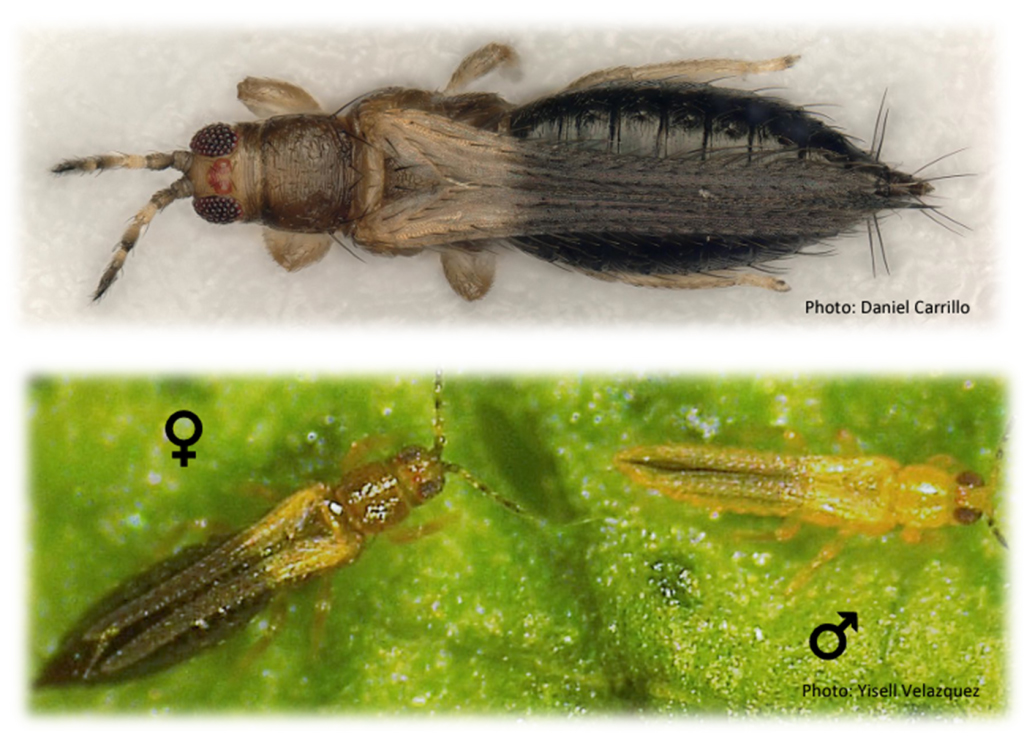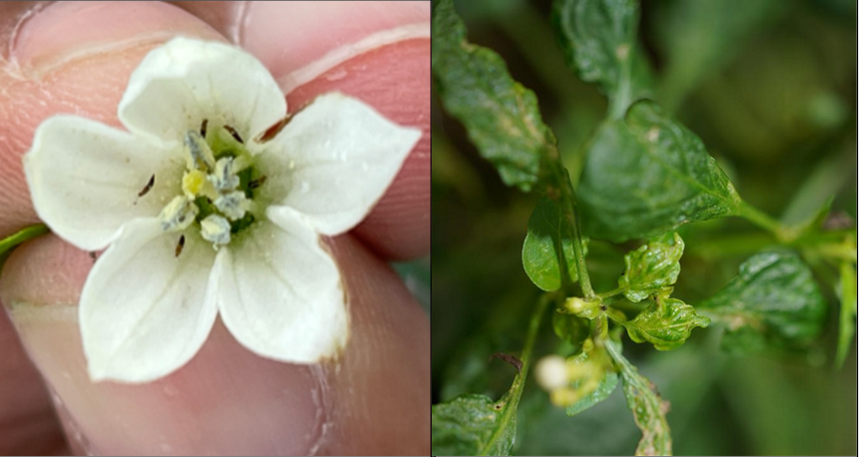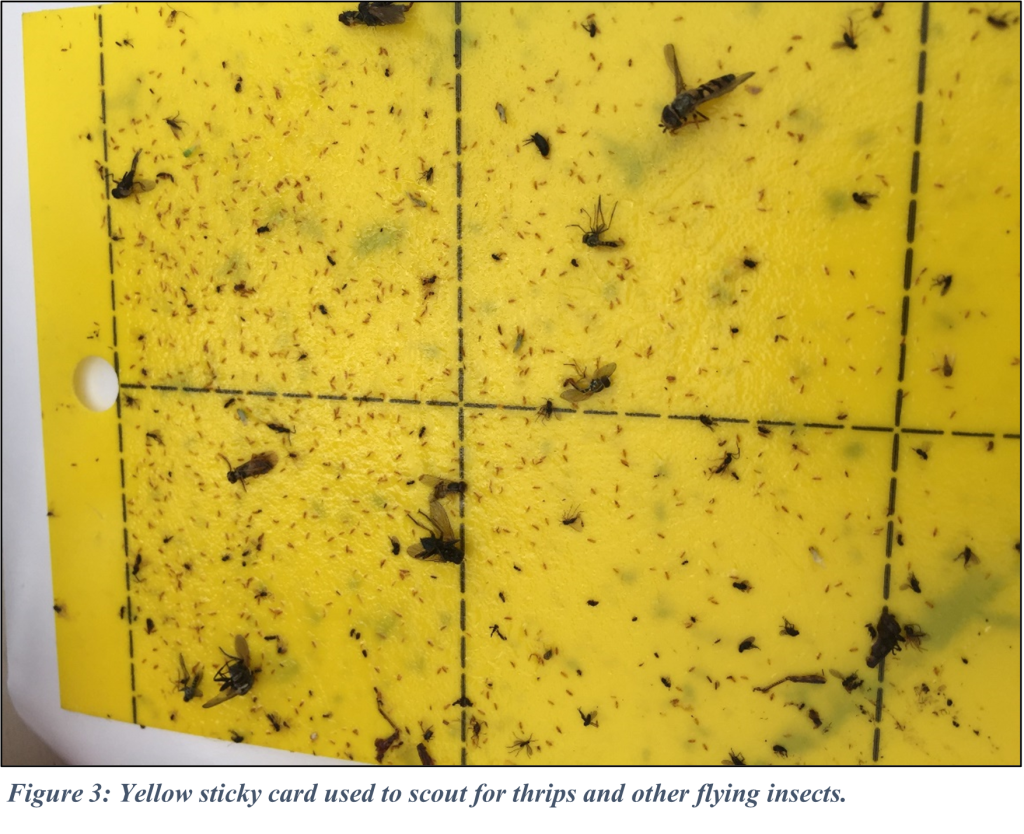An invasive thrips species, Thrips parvispinus, commonly known as the Pepper Thrips, is emerging as a destructive new pest in North America. Native to southeast Asia, it has spread globally through the horticultural industry. First intercepted in the U.S. in Hawaii, it is now widespread within Florida and threatens to move into the rest of the country through shipments of ornamental and vegetable plants. This article will outline valuable information available on the known host range of plant material Pepper Thrips can attack, how they are to be identified, and what chemical strategies have been evaluated for combatting this newly developing pest.
Scouting & Identification
Feeding damage to leaves, buds and flowers causes abnormal growth, including dwarfed growing tips that can mimic broad mite damage in some cases. Because the T. parvispinus is new to North America, the list of host plant species is changing rapidly, but some key ornamental and vegetable crops have been documented as shown in the table below. University of Florida, who is leading the charge in Pepper Thrips research, now lists over 40 susceptible crops.
| Tropicals | Fruits and Vegetables | Spring Bedding |
|---|---|---|
| Gardenia | Pepper | Gerbera Daisy |
| Dipladenia | Bean | Chrysanthemum |
| Hibiscus | Cucumber | Marigold |
| Mandevilla | Squash | Dahlia |
| Anthurium | Zucchini | Sunflower |
| Schefflera | Strawberry | Flowering Vinca |
T. parvispinus are the smallest dark thrips (smaller than Chilli Thrips) that growers are likely to encounter during production. Females and males differ in size and color. Females are approximately 1 mm long (i.e., a little over 1/32 in), and males are almost half the size at 0.6 mm long. Males are yellow, while the females have a brown head, black abdomen, and a distinctive yellow thorax (Figure 1). The wings are dark, with light a colored base where they overlap the thorax. The third antennal segment and the base of the fourth and fifth segments are light colored, giving them a broken or “striped” pattern. All leg segments are light colored.
Under controlled conditions on chili pepper (Capsicum annuum L.) in greenhouses, the life cycle is completed in 13 to 14 days. Eggs are inserted into leaves; after four to five days, larvae hatch to feed on leaves and flowers. Larvae go through two molts in four to five days, mature and pupate. The two pupal stages last two to three days. Reproduction is sexual and on average females lay 15 eggs. Mated females live nine days. Adult males live six days.

Figure 1: Male (bottom right) and female Pepper Thrips (top and bottom left),
Photo source: UF, IFAS
T. parvispinus prefers tender young growth but will also feed on flowers and fruit (Figure 2). They are difficult to find on foliage due to their size and ability to hide in the deformed growth but are easily spotted on the flowers of tropical ornamentals, where they can be found inside the flower or hiding between overlapping petals.

Figure 2: Pepper Thrips on Pepper flower (left) and foliage (right), Photo Source: UF, IFAS
Scouting tools should include a good hand lens and a white sheet of paper on a clipboard to conduct a beat test. As with other thrips species, yellow or blue sticky cards are also effective at detecting their presence (Figure 3).
For more information on scouting and identification of Thrips parvispinus, please visit the University of Florida Tropical Research & Education Center resource page at: https://trec.ifas.ufl.edu/people/alexandra-revynthi/thrips-parvispinus/

Photos from the University of Florida sourced from: https://mrec.ifas.ufl.edu/lsolab/thrips/thrips-parvispinus/
Crop Protection Strategies
Recent research conducted by the University of Florida, US Dept of Ag, and Cornell University tested a wide range of pesticides for efficacy against Pepper Thrips (Ataide et al., 2024, https://doi.org/10.3390/insects15010048). In the study, mortality and leaf feeding damage were quantitatively assessed separately for adult thrips and the two larval stages. This detail provides strong insight into the action of the insecticides tested. The tiers of chemical efficacy below are based on the mortality ratings of this study, which is the best information currently available. Rankings may change as new data becomes available. The three pesticides found to be most effective include Pylon (MOA 13), Conserve (MOA 5) or XXpire (MOA 4C+5) in the referenced research, link above. These three products cause mortality in all life stages and are designated as Tier 1 in the tables below. Note the overlapping mode of action of XXpire with Conserve. Tier 2 products showed reduced activity compared to Tier 1 products but were still efficacious against all life stages. These products should be used as secondary controls once the pest population is diminished. Tier 3 products caused some mortality, primarily to the L1 larval stage, with reduced or little activity on L2 larvae and adults typically. Met 52 OD is grouped with Tier 2 due to its overall activity in a separate trial.
Tier 1 – Most Effective Controls for Pepper Thrips, Efficacy Against All Life Stages
| Product Name | MOA | Item Number | Comments |
|---|---|---|---|
| Conserve SC | 5 | 70-1365 | Do not rotate with XXpire; allows 4 apps per year maximum inside greenhouse |
| Pylon | 13 | 70-2675 | 3 apps per crop maximum, indoor applications only |
| XXpire | 4C+5 | 70-9700 | Do not rotate with Conserve |
Tier 2 – Lower Mortality, Efficacy Against All Life Stages
| Product Name | MOA | Item Number | Comments |
|---|---|---|---|
| Hachi-Hachi | 21A | 70-1795 | Mostly effective against immature stages, phyto cautions |
| TriStar | 4A | 70-85221 | Max label rate only for all thrips species |
| M52 OD** | UNF | 70-2291 | Foliar – apply 3 times 7 days apart. Drench has long lasting soil pupae activity |
Tier 3 – Primary Effect on First Stage Larvae (L1)
| Product Name | MOA | Item Number | Comments |
|---|---|---|---|
| Acephate | 1B | 70-1105 | High bee hazard, do not rotate with Carbaryl |
| Aria WDG | 29 | 70-3399 | Direct spray has moderate efficacy on larval stages |
| Altus | 4D | 70-1161 | Direct spray showed good efficacy on L1 larva, some L2 |
| BioCeres WP | UNF | 70-1245 | Outperformed BotaniGard in 1 FL trial |
| Marathon II | 4A | 70-23712 | Moderate effect on L1 larva only; TriStar is better (Tier 2) |
| Carbaryl | 1A | N/A | High bee hazard, do not rotate with Acephate |
| Kontos | 23 | 70-19601 | Trial as a drench, residue gave moderate mortality of larvae |
| Overture | UN | Single use water soluble packets | |
| Pedestal SC | 15 | 70-29501 | Insect growth regulator activity, immatures only. Tank mixable |
| Sarisa | 28 | 70-2975 | Good residual activity for L1 larval stage |
Control strategies against Pepper Thrips start with experience for controlling Western Flower Thrips. Using the limited chemical data available and our understanding of the thrips life cycle, GGSPro recommends using foliar sprays twice in a row, 5-7 days apart for short crop protection (under 12 weeks), before rotating to a new mode of action (MOA). This method improves control in many cases and treats each generation of thrips with a specific mode of action, ultimately slowing the carryover of genetic traits for resistance. For longer crop protection (13 weeks or longer), single sprays should be used, alternating the available MOAs to allow the number of uses to span the longer crop cycle. Additional research is needed to determine appropriate rates, frequency, and economic viability for biological control agents (BCAs). This includes Amblyseius cucumeris and swirskii, Orius insidiosus and Atheta coriaria which are well researched for Western Flower Thrips, but not yet for Thrips parvispinus.
Note, not all products are registered in all states. Some pesticides are restricted use in some states or regions and not others. It is the responsibility of the applicator to read and follow all label directions including potential phytotoxicity/plant tolerance statements, remembering that labels may change. Rates, application methods, and edible status are detailed in our GGSPro Insecticide & Fungicide Guides. Griffin also offers the 5th Edition GGSPro Technical Reference Guide in both English and now Spanish versions. This valuable resource outlines a wide range of pest control options along with information on pollinator safety, BCA’s, scouting, weed management, plant lighting, nutrition, water quality and more!
*Contact Griffin Greenhouse Supplies for product numbers and pricing information on BCA options.
